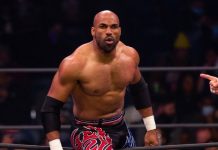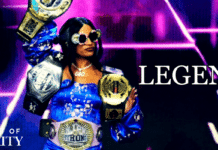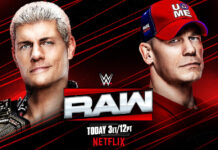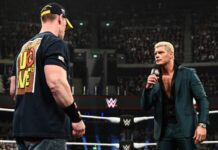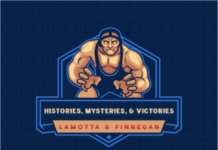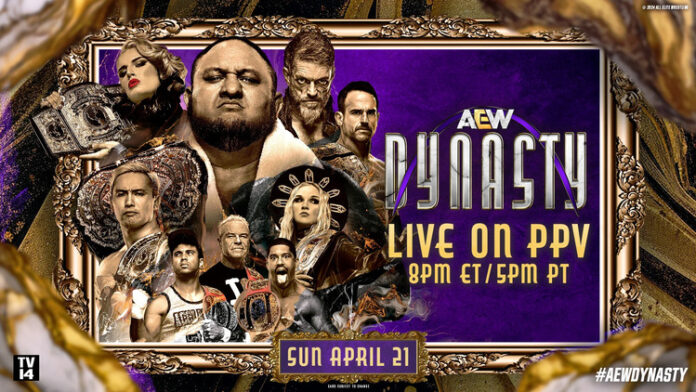
The first ever AEW Dynasty pay-per-view was held in St. Louis, a historical pro wrestling city built by Sam Muchnick, Larry Matysik and others of the territory era. The live crowd reflected that as they stayed involved in the action throughout the night, despite the fact that the runtime of the broadcast was just over four hours. The main card had nine matches, which again proved to be problematic at certain points, but that’s basically just the nature of Tony Khan pay-per-view cards. While Revolution had a much better pace last month with bouts that had shorter times than some of the more featured contests, Dynasty fell into the typical Khan PPV pitfall of an obligatory 20-minute slot for almost the entire card without taking into account if the match up or the storyline around it justified that amount of time for the segment.
I have to be honest, I was very surprised that Kazuchika Okada, former IWGP Heavyweight champion and one of Tony’s recent high-priced acquisitions, opened the show with the Continental title defense. Okada, given his standing among the diehard All Elite audience that is willing to order the $50 pay-per-views and the skills he brings to the table, simply isn’t an opening match guy. It’s more about the presentation and the message that it sends rather than anything that is beneath him. Reportedly, Khan paid Okada some hefty cash and rightfully so, to leave the top spot in New Japan and move to the United States. Granted, with the financial security that such a contract brings, it’s difficult to image that Okada is going to complain about where he’s scheduled on the card, but again, based on the level of investment that the company made in the Japanese superstar, putting him on first doesn’t spotlight him as the main event talent that he should be. On the flip side, a co-main event spot continues to give the impression that the signing of New Japan’s top star was a big deal, and it is.
As far as the match itself, it was essentially what you’d expect from two excellent workers like these two grapplers. Everything they did was crisp and smooth. The opening sequences of technical exchanges was top notch pro wrestling and emphasized their talent. As the match progressed there was a DDT spot that looked brutal, and throughout the contest, Okada occasionally gave a smirk, generating jeers from the crowd. The character work is really valuable stuff, as it will give more depth to Okada’s character and thus more can be done with him in storyline for hopefully a bigger spot on pay-per-view. The counters toward the finish of the match were very well done and it built toward the conclusion. Okada retained the belt for a really solid bout.
The problem is, particularly with Pac’s sporadic at best schedule, is that this match-up was basically a one-off that has very little impact in the grand scheme of things. Pac’s agreement with All Elite is rather odd, as he is only on television for a handful of appearances once every few months so despite his stellar talent, he’s not on the show long enough to truly get over or stay over with the audience. His lack of regular appearances don’t allow for the audience to get the chance to invest in his character or the direction his persona takes on the shows. So, that reduces his work in All Elite to just the move set, including a great moonsault to the outside during the bout with Okada, but there are a lot of great in-ring talents on the AEW roster so it’s somewhat puzzling why Pac is still signed to the company without a regular schedule. For an organization that is desperate to draw TV ratings, Pac isn’t a guy that can help move the needle since he’s not on the show enough to make a difference. Furthermore, as talented as he is, if he’s not there enough to get over beyond the move set, would it truly make a difference if he was released? Don’t get me wrong, Pac is a tremendous talent, but his standing within the company is minimal since he’s often not there so the Okada bout was almost an exhibition.
In some ways, you could make the argument that part-time Pac isn’t the best use of the British athlete, or that maybe booking Okada in the opener didn’t emphasize his star power. In a similar fashion, the six man tag team contest that saw Adam Copeland, Mark Briscoe, and Eddie Kingston compete against The House of Black was another case of miscast talent on this show. The former Edge didn’t leave the comfort of the WWE and the relatively easy paycheck he could’ve collected until he decided to hang up his boots for peanuts. He’s another high-priced talent on the All Elite roster, and so far, all that he has done was rehash history from the WWE. Sure, the feud with Christian was good storytelling, but should it have been the first angle that he did in All Elite? Copeland debuted in AEW four months ago, working a dozen matches so far, but hasn’t competed against any of the top stars on the All Elite roster. At 50, Copeland is obviously at the latter stages of his career, there should be a priority to get some of those marquee matches that are unique commodities that can be promoted for the organization. Within four months, the guy that looked like a major signing is booked in a throwaway tag in the second match of a four-hour card.
The optics look like this contest was booked just to shoehorn a few extra names on the card. As great as The House of Black are, taking into account that they don’t seem to want to do the job for opponents too often, or at least that was the rumor, and the concept of a trios division is still very flimsy, they could’ve worked a six man tag on the preshow to allow for better use of PPV time. Eddie Kingston is still one of the most over stars on the roster, and I really think a lot more can be done with him from a storyline perspective, but he’s also in a random six man for the second match of the night. The match itself was fun, as it had a lot of action and showcased each participant, but unless there’s some angle to develop from this, and there might be, then it was just another PPV exhibition. The finish saw Copeland get pinned after taking the mist to the face so perhaps there will be more to the storyline in the next few weeks.
I’ve already mentioned that presentation can impact perception, and that was also the case with the TBS championship contest, as it went just five minutes, giving a clear indication of the lack of faith that the office has in the disarray of the women’s division. The Wrestling Observer’s Dave Meltzer reported that Julia Hart is dealing with an injury, and it that is accurate then the argument could be made that the switch should’ve been done on television to allow for a better representation of the women’s division on the bigger star of the pay-per-view. If the belt switches in five minutes on TV, there’s not much that can be taken from it, considering that there was timing issues with TBS broadcasts on a semi-regular basis, but for such a short match at Dynasty, it gives the impression that management didn’t trust the quality of a longer contest. Willow got the win to claim the title, and a match against Mercedes Mone was announced for Double or Nothing next month.
The International title means very little among the pro wrestling landscape, but Roderick Strong/Kyle O’Reilly was a really solid bout that added a lot of substance to the card in terms of quality, especially for an event that had the primary selling point of work rate over storylines. Sure, it was similar to contests that they’ve had before, but again, quality is quality, as far as physical and solid pro wrestling. Strong retained the belt, and Adam Cole made a rather pointless cameo appear to show the fans that he doesn’t need the wheelchair, which more or less ruined any element of surprise that could’ve been used when he’s actually ready to to return to the ring. He just showed up, walked down the ramp, and stood in the ring. He’s a superb talent, but he didn’t look like the leader of a faction or a star in this segment.
Speaking of pointless, the FTW title match didn’t do anything to help anyone, not Chris Jericho, Hook, or the viewing audience. Make no mistake about it, in many respects, Chris Jericho is in a league of his own, but at 53, he’s understandably beginning to show his age in the ring. For a guy that was always ahead of the curve and reinvented himself to stay fresh, the fact that he had to go back to the Lion Heart moniker might be an indication that it’s time to hang up the boots. When you add the controversy that made the rounds online a few months ago and wasn’t ever addressed or disputed, it doesn’t endear him to the audience. The bout had its moments with a brutal suplex from the apron to the floor through a table and another suplex when Jericho had a trash can over his head, but the bulk of the match was very clunky and flat. There was no pace and it almost exposed Jericho for being maybe a step or two behind at some points. Hook actually kicked out of the Judas Effect, a finisher that was protected, but it didn’t get a reaction from the crowd because the segment had no momentum at all. It didn’t help that Jericho won the FTW title because there’s a fine line between working with younger talent to help elevate them, and working with younger talent to try to stay relevant. Unfortunately, it appeared to be the latter in this segment. So far, this storyline made Hook seem aloof, and unless there are some better plans for him in the future, he might want to try to get a tryout with WWE. Maybe this angle would’ve worked better a year or so again when he still had a surge in popularity, but they might’ve missed the boat on that opportunity. Jericho won the title, but there weren’t any winners in this segment.
The Women’s title match was fine, nothing subpar, but nothing too spectacular either. Thunder Rosa isn’t nearly as popular as she was prior to the injury that put her on the shelf for an extended period of time or the speculation that she was difficult to work with backstage. The segment went 15 minutes and they could’ve accomplished the same narrative in about half of the time so the pacing wasn’t ideal. Toni Storm retained the title, and she’s a really good performer, but there women’s division lacks the depth of capable opponents to challenge her for the championship.
At this point in the show, the event was a mixed bag in terms of quality, but the last three matches were truly the meat of the matter so to speak. If the final portion of the PPV delivered then you could chalk Dynasty up as a success. Of course, Dave Meltzer already proclaimed that Will Ospreay/Bryan Danielson was potentially the greatest match ever, which is completely misguided. With Kenny Omega injured indefinitely and in the latter stages of his career, Meltzer picked a stellar athlete ten years younger to bet his contrarian chips on now. It gives Meltzer a debatable topic to continue to keep his newsletter in the conversation. No matter how well Cody or The Rock draw for WWE, Meltzer will counter with, “but they aren’t Will Ospreay.” Sure, it’s a completely one-dimensional viewpoint, but it serves his base, which is a very smart business move.
That being said, Bryan Danielson vs. Will Ospreay was a classic and an incredible performance from both of them. I’m just not going to jump to the conclusion that it was a better drama than Bret/Stone Cold or as epic as Misawa vs. Kawada, especially because Meltzer makes those claims more to serve an agenda than anything else.
The crisp and fast-paced action was tremendous. There was an exciting pace to the contest that kept the audience involved as the momentum tilted back and fourth. Similar to Ospreay/Konosuke Takeshita at Revolution last month, when you have two of the best in-ring workers in the business, in this case, Ospreay and Danielson working this type of style, anyone else that tries to compete with the same style on the show seems completely secondary. The spot where Danielson intercepted the British grappler with a knee strike was incredible. Ironically, the only portion of the bout that I completely disagreed with was the finish. Ospreay got the victory, which is completely fine, he has the potential to be a major deal for All Elite in the future. However, the worked injury was low brow, completely unnecessary, and added nothing to the segment. In the modern era, head injuries or neck injuries being used in storylines seem sleazy. That becomes even more apparent when a neck injury is used for an angle with a guy that has a history of very serious head injuries.
The Tag Team title ladder match was the car crash segment you’d expect and there were definitely some dangerous moments, particularly when Dax looks like he slipped when he landed a pile driver on the ladder. This segment had the thrills and bumps that made it stand out. The finish saw Jack Perry return to the company to help The Young Bucks win the championships. This comeback from an eight-month suspension was booked after the backstage fight footage was aired on Dynamite. Given his comments in the past and the way that he conducted himself at Wembley Stadium, I honestly don’t think that Perry has the mindset to ever be a major star in pro wrestling. I still don’t think airing the footage was a good idea and it definitely won’t do anything to propel Perry’s career. He was choked and had no offense in the backstage fight. His return right after the footage aired is pointless because there’s no payoff for AEW. Perry gets heat because he was the guy that ultimately cost the company CM Punk, but the real-life Phil Brooks works for WWE so it’s not as though Tony Khan can book Punk/Perry to get a payoff or draw money from this fiasco. As I wrote previously, Jack Perry is expendable so I don’t think anything of importance will be possible with this return to the company.
Samoa Joe vs. Swerve was a quality main event match. Everything they did was solid and there was a level of drama as the match built toward the conclusion. The only problem was, the audience just saw the dazzling 30-minute spot fest of Ospreay/Danielson and then the car crash ladder match with FTR/The Bucks so there just wasn’t a lot of new ground for them to cover on the pay-per-view. Joe was essentially used as a transitional champion, and that’s not completely a negative, but all things considered, he should’ve been used for more than that. In many ways, the bulk of his four-month title reign consisted of him booked as the third wheel in the Swerve/Adam Page feud. I still don’t get exactly what Strickland’s character is supposed to be, but he’s undoubtedly very popular with the AEW audience so this was a wise decision. That might be the biggest takeaway from the entire pay-per-view, the company needed something positive take place after the past few weeks of negative publicity, and the Swerve victory gives the organization a great moment to highlight the conclusion of the pay-per-view.
What do you think? Share your thoughts, opinions, feedback, and anything else that was raised on Twitter @PWMania and Facebook.com/PWMania.
Until next week
-Jim LaMotta
E mail [email protected] | You can follow me on Instagram, Facebook, & Threads @jimlamotta89

